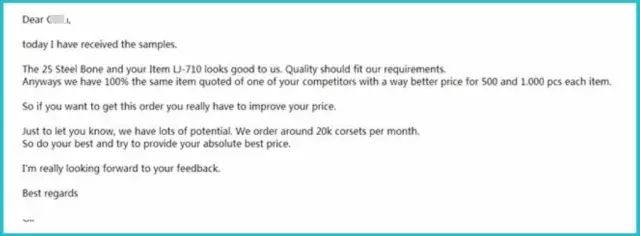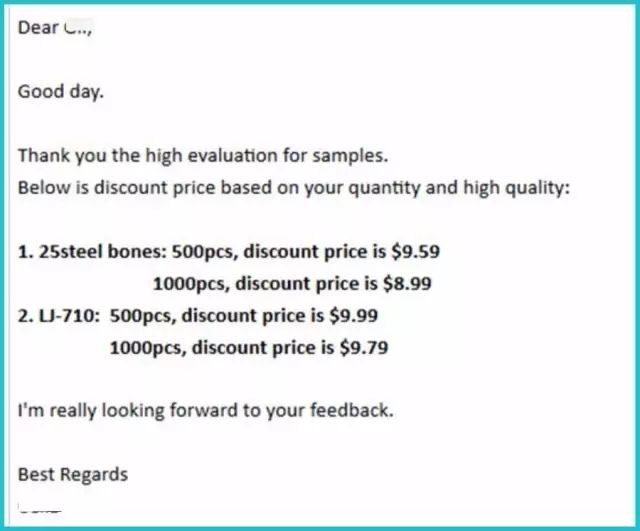Your Strategic Partner for
Unlocking China's Sourcing Potential
Case analysis | How did the suppliers cleverly deal with your bargaining?
In today’s increasingly transparent international trade market, price games have become a fact that many foreign traders cannot escape.
Under this round of price crushing, how did the sellers cleverly deal with it?
Today, let’s take a look at the example sharing of salesperson C.
First, an email from salesperson C and the customer:

In this email, you can see that the customer is very satisfied with the quality of the samples, but the customer is very shrewd, saying that they have received better prices from other suppliers, and they also revealed their monthly order quantity.
After salesman C received this email from the customer, he thought about the following aspects:
- Is the quotation correct?
- Is the price really high?
- Do I need to lower the price?
- When is it appropriate to lower the price?
- Is there a reason for the price reduction?
- How to reduce the price?
The first point: Is the quotation correct?
Grasp of the quotation:
1. The quotation amount should not be an integer as far as possible, it should be a zero number so that customers have a sense of closeness with the product quotation from the perspective, such as 11.5 yuan/piece;
2. It is necessary to reserve the room for bargaining. Generally, it is recommended to have 15%-20% flexibility;
3. Appropriate price should have sufficient conditions to let customers understand.
After doing the first point of analysis, salesman C reply:

Soon, he received the following reply from the customer:

After the first round of price reductions, the customer still felt that the price was high, and salesperson C made the following analysis:
The second point: Is the price really high?
Tell the specific reasons for the high price (high value for money, you get what you pay for):
1. Our raw materials are not the same as the ordinary materials used by other suppliers;
2. Our products are made of imported equipment, which maximizes the guarantee of excellent workmanship and stable performance;
3. Our production technology is more advanced, and both hardware and software are trustworthy;
4. The product is produced in a dust-free workshop, which maximizes product hygiene;
5. In order to control the quality, our products are fully inspected to maximize the quality;
6. Our factory has done FDA certification or SA8000 certification, which maximizes the guaranteed process standard, stable quality, and sanitary production environment.
Analyze the advantages of the product from raw materials, technology, hygiene, quality, delivery, certification. After listing the above advantages, the customer did not reply for a week.
Salesman C made the following judgment: The customer’s request for a price reduction is a natural response.
Customers requesting price reductions are divided into two categories, one is customers familiar with the industry, and the other is ordinary customers.
The third point: Do I need to lower the price?
Clarify the following points and give customers a step down:
1. Whether the customer has an order on hand;
2. Can I get an order if the price is reduced?
Salesperson C took the initiative to send the following email to the customer to explore the true intention of the customer:

Purpose of the mail:
1. Let customers reply to emails, indicating their willingness to cooperate;
2. Get information from the customer, match the quantity with the price, and decide the next step in the negotiation.
The fourth point: When is it appropriate to lower the price?
1. When you will lose customers without lowering the price;
2. When the price can be reduced to win customers;
The game of quantity and price, the grasp of customer psychology, and the timing of price reduction.
The fifth point: Is there a reason for price reduction?
1. Payment method: Originally T/T 30% deposit, the balance is paid on the COPY of the bill of lading. Can the customer accept T/T35% deposit?
2. Delivery deadline: originally 30 days, can 35 days be agreed?
3. Additional conditions: A. Can you increase the quantity; B. Can you give a stable order?
The price can be reduced, but the price cannot be reduced for no reason, plus some favorable conditions for yourself.
The sixth point: How to reduce the price is appropriate?
1. Do not reduce the price too much each time;
2. The number of price reductions should not exceed 3 times as much as possible. Frequent price reductions make customers more and more courageous, and they can’t wait to drain the profits of the supplier;
3. It is best to use a trapezoidal price reduction method, the ratio should be smaller and smaller, for example, the first time is 2%, the second time is 1%, and the third time is 0.5%, so that customers feel that the supplier has been desperately reducing the price.
